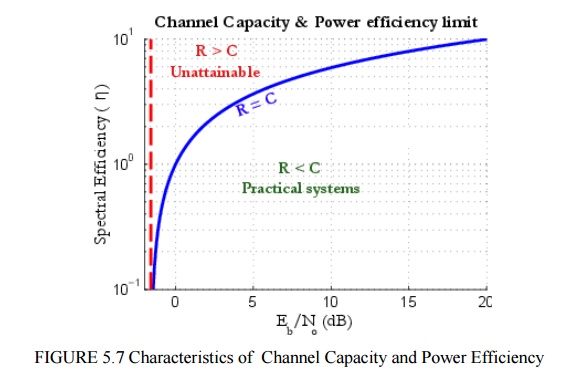Chapter: Communication Theory : Information Theory
Shannon-Hartley Theorem
SHANNON–HARTLEY THEOREM:
In information
theory, the Shannon–Hartley theorem tells the maximum rate at which information
can be
transmitted over a
communications channel of a
specified bandwidth in the presence of noise.
It is an
application of the noisy channel coding theorem to the archetypal case of a continuous-time analog communications
channel subject to Gaussian noise. The theorem
establishes Shannon's channel capacity for such a communication link, a
bound on the maximum amount of error-free digital data (that is, information)
that can be transmitted with a specified bandwidth in the presence of the noise
interference, assuming that the signal power is bounded, and that the Gaussian
noise process is characterized by a known power or power spectral density. The
law is named after Claude Shannon and Ralph Hartley.


Considering
all possible multi-level and multi-phase encoding techniques, the
Shannon–Hartley theorem states the channel capacity C, meaning the theoretical
tightest upper bound on the information rate (excluding error correcting codes)
of clean (or arbitrarily low bit error rate) data that can be sent with a given
average signal power S through an analog communication channel subject to
additive white Gaussian noise of power N, is:

Where C
is the channel capacity in bits per second;
B is the
bandwidth of the channel in hertz (passband bandwidth in case of a modulated
signal);
S is the
average received signal power over the bandwidth (in case of a modulated
signal, often denoted C, i.e. modulated carrier), measured in watts (or volts
squared);
N is the
average noise or interference power over the bandwidth, measured in watts (or
volts squared); and
S/N is
the signal-to-noise ratio (SNR) or the carrier-to-noise ratio (CNR) of the
communication signal to the Gaussian noise interference expressed as a linear
power ratio (not as logarithmic decibels).
APPLICATION & ITS USES:
1. Huffman
coding is not always optimal among all compression methods.
2. Discrete
memory less channels.
3. To find
100% of efficiency using these codings.
Related Topics